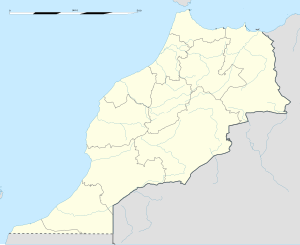| Battle of Wadi al-Laban | |||||||
|---|---|---|---|---|---|---|---|
| |||||||
| Belligerents | |||||||
| Saadi Sultanate |
| ||||||
| Commanders and leaders | |||||||
| Abdallah al-Ghalib | Hasan Pasha | ||||||
| Strength | |||||||
| Unknown | Unknown | ||||||
| Casualties and losses | |||||||
| Unknown | Unknown | ||||||
Location of the battle of Wadi al-Laban in
Morocco. | |||||||
The Battle of Wadi al-Laban ( Arabic: معركة وادي اللبن) occurred in March–April 1558 between Saadians and Ottoman Algerian forces under Hasan Pasha, the son of Hayreddin Barbarossa. It took place north of Fes, at Wadi al-Laban, an affluent of the Sebou River, one day north of Fes. [1]
Background
This conflict took place in a context of tensions between Algeria and Morocco. [2] [3] [4] Hasan Pasha son of Hayreddin Barbarossa, the ruler of the Regency of Algiers on behalf of the Ottoman Empire, captured Fes from the Saadians in early 1554 and installed a Wattasid client. The Saadian ruler Mohammed al-Shaykh recaptured the city later that year. [1] Following the return of the Saadians, numerous conflicts broke out between Algeria and Morocco, which tried to annex the Algerian city of Tlemcen. [5] Mohammed al-Shaykh subsequently sought an alliance with the Spaniards who were occupying Oran at the time and were fighting the Ottomans as well, but the agreement failed to materialize.
Hasan Pasha, the son of Barbarossa, was reappointed beylerbey of Algiers by the Ottoman sultan Suleiman I in June 1557. The Ottomans sent the Saadian sultan an embassy demanding he recognize the overlordship of the Ottoman sultan, which Mohammed al-Shaykh refused. [1] Mohammed al-Shaykh was then assassinated in October 1557 by Turkish officers sent by Istanbul and entered into Saadian service under the pretense of being deserters. He was succeeded by Abdallah al-Ghalib. [1]
Meanwhile, the Saadians had occupied Tlemcen in 1556 but failed to capture the Machouar palace while the Ottoman Algerians were busy besieging the Spaniards in Oran. After Mohammed al-Shaykh's death, Hasan Pasha marched west, forcing the Saadians to abandon Tlemcen. [1]
Battle
Led by Hasan Pasha, the Ottoman force pursued the retreating Saadian army into Morocco. [1] [6] An indecisive battle between the two sides took place in Wadi al-Laban to the north of Fez in early 1558. [1] [7] [8] [9]
Aftermath
After the battle, Hasan Pasha decided to retreat upon hearing of Spanish preparations for an offensive from Oran in Western Algeria. [1] [10] He embarked with his troops at the port of Qassasa in northern Morocco, just west of Melilla, and from there sailed to Algiers to prepare a defense against the Spaniards, who soon attacked in the Mostaganem expedition. [1]
Some sources attribute a victory to either Hassan [11] or Abdallah. [12] Abdallah al-Ghalib later sent an expedition against Tlemcen in 1560 but it was defeated. [13] [14]
See also
Notes
- ^ a b c d e f g h i Abun-Nasr, Jamil M. (1987). A History of the Maghrib in the Islamic Period. Cambridge University Press. pp. 157–158. ISBN 978-0-521-33767-0.
- ^ Véronne, Chantal de La (1997-01-01). Histoire sommaire des Sa'diens au Maroc: La première dynastie chérifienne, 1511-1659 (in French). FeniXX réédition numérique. ISBN 978-2-307-06107-6.
- ^ Cour, Auguste (2004-09-10). L'établissement des dynasties des Chérifs au Maroc et leur rivalité avec les Turcs de la Régence d'Alger, 1509-1830 (in French). Editions Bouchène. ISBN 978-2-35676-097-5.
- ^ Péchot, L. (1914). Histoire de l'Afrique du Nord avant 1830: précédée de la géographie physique et politique de la Tunisie, de l'Algérie et du Maroc (in French). Gojosso.
- ^ De La Veronne, Chantal (1973). "Relations entre le Maroc et la Turquie dans la seconde moitié du XVIe siècle et le début du XVIIe siècle (1554-1616)". Revue des mondes musulmans et de la Méditerranée. 15 (1): 391–401. doi: 10.3406/remmm.1973.1258.
- ^ Konstam, Angus (2016-08-25). The Barbary Pirates 15th-17th Centuries. Bloomsbury Publishing. ISBN 978-1-4728-1544-6.
- ^ Konstam, Angus (2016). The Barbary Pirates 15th-17th Centuries. Bloomsbury Publishing. p. 25. ISBN 978-1-4728-1545-3.
- ^ Stapleton, Timothy J. (2013). A Military History of Africa [3 volumes]. ABC-CLIO. p. 36. ISBN 978-0-313-39570-3.
- ^ Black, Jeremy (2022). A Brief History of the Atlantic. Little, Brown Book Group. ISBN 978-1-4721-4590-1.
- ^ Charles André Julien (1970). History of North Africa: Tunisia, Algeria, Morocco, from the Arab Conquest to 1830. Routledge & K. Paul. p. 296. ISBN 978-0-7100-6614-5.
- ^ Yver, G. (1993) [1927]. "Hasan Pasha, Beylerbey of Algiers". First Encyclopaedia of Islam 1913-1936. Brill. p. 281. ISBN 978-90-04-09796-4.
- ^ Véronne, Chantal de La (1997). Histoire sommaire des Sa'diens au Maroc: La première dynastie chérifienne, 1511-1659 (in French). P. Geuthner. p. 37. ISBN 978-2-307-06107-6.
- ^ The Last Crusaders: East, West and the Battle for the Centre of the World. Barnaby Rogerson. Hachette UK.
- ^ History of Islam: Classical period, 1206-1900 C.E. Masudul Hasan. Adam Publishers & Distributors.
